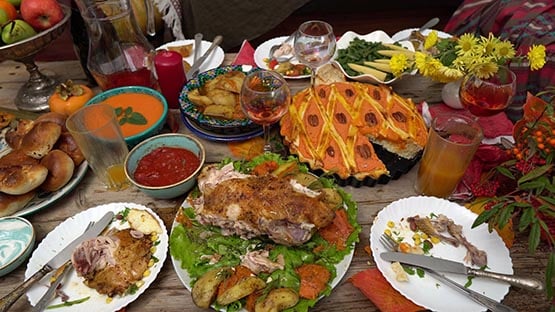
For many families, the Thanksgiving feast is the most anticipated meal of the year. But just as important as it is delicious, it’s important that it is safe to eat and store. After all, the turkey sandwiches and leftover pumpkin pie can be enjoyed for days.
Melissa Wright, director of Virginia Tech’s Food Producer Technical Assistance Network, and Alexis Hamilton, assistant professor of food processing microbiology, are both faculty members in the Virginia Tech College of Agriculture and Life Sciences Department of Food Science and Technology.
They shared holiday food safety tips of many sorts in advance of the Thanksgiving holiday.
“Of course, when handling food, the first rule is to wash your hands,” said Wright. “Use warm water and soap, washing for at least 20 seconds. Dry your hands on a clean towel or disposable paper towel. Don’t use the same dish towel all day for all kitchen tasks.”
Wright said to keep in mind any guests food allergies or sensitivities.
“Making cards to identify a dish and any potential allergens (wheat, milk, soy, peanuts, tree nuts, eggs, fish, shellfish and sesame) would be a thoughtful gesture to your guests.”
Wright said that if you are cooking, you should also have a food thermometer on hand.
“Measuring the internal temperature of cooked foods is an important part of food safety,” said Wright. “Measurements should be taken with a food thermometer.”
Recommended internal temperatures
- Poultry (including whole, parts and stuffing) should be cooked to an internal temperature of at least 165°F.
- A ham cooked from fresh or smoked should be cooked to an internal temperature of at least 145°F with a 3-minute rest time before carving.
- A reheated, fully cooked ham should be cooked to an internal temperature of at least 140°F.
- Casseroles and leftovers should have an internal temperature of at least 165°F.
“Once the meal is over, if there’s anything left unfinished, those leftovers too need to be safely stored and handled,” Hamilton said. “It’s important to keep food out of the danger zone, which is the temperature between 41°F and 135°F. It’s important that foods pass through this range as quickly as possible. Basically, keep hot foods hot and cold foods cold.”
Other tips
- If you are working with foods fresh from the oven or stove, once removed and placed on the table or tray, there are about four hours to consume, store, or reheat. For foods that were kept in the refrigerator, the time increases to six hours. At that point, a decision must be made to eat, store, or throw out the remaining foods.
- For storing hot foods, it’s important to let them cool a bit before placing them in either the fridge or freezer.
- To properly cool foods, follow two-stage cooling guidelines. Stage 1 involves cooling food from 135°F (57°C) to 70°F (21°C) within the first 2 hours. Stage 2 involves cooling from 70°F (21°C) to 41°F (5°C) within the next 4 hours.
- The best way to ensure proper and safe cooling is to divide large amounts of leftovers into shallow containers.
- Regardless of the type of food, toss the leftovers within three to four days of being placed in the fridge.
“Three to four days might not seem long enough,” Hamilton said. “One thing you could do to maximize leftovers involves putting meals onto plates, placing that amount only in the fridge, and putting the rest of the food in the freezer, where it can safely keep for one to three months. However, you should keep in mind that more moisture evaporation will happen the longer the food stays in the freezer, which will change the flavor.”
Safe durations for storage
- Casserole-style foods: Three to four days in the fridge and up to four months in the freezer.
- Cooked bacon: Lasts up to a week in the fridge and two to three months in the freezer.
- Cooked fish: Three to four days in the fridge, four to six months in the freezer.
- Cooked ham: Three to four days if sliced, a week if whole in the fridge. Cooked ham lasts one to two months in the freezer.
- Cooked meat: Three to four days in the fridge, two to three months in the freezer.
- Cooked poultry: Three to four days in the fridge, four months in the freezer.
- Macaroni and cheese: Three to four days in the fridge and up to two months in the freezer.
Warning signs that food has gone bad
- Has something growing on it
- Smells abnormal
- Has a weird taste
- Has a funny texture
If you’re not sure if the food is still good, it’s safer to throw it out. A good rule is, “When in doubt, throw it out,” Hamilton said.










